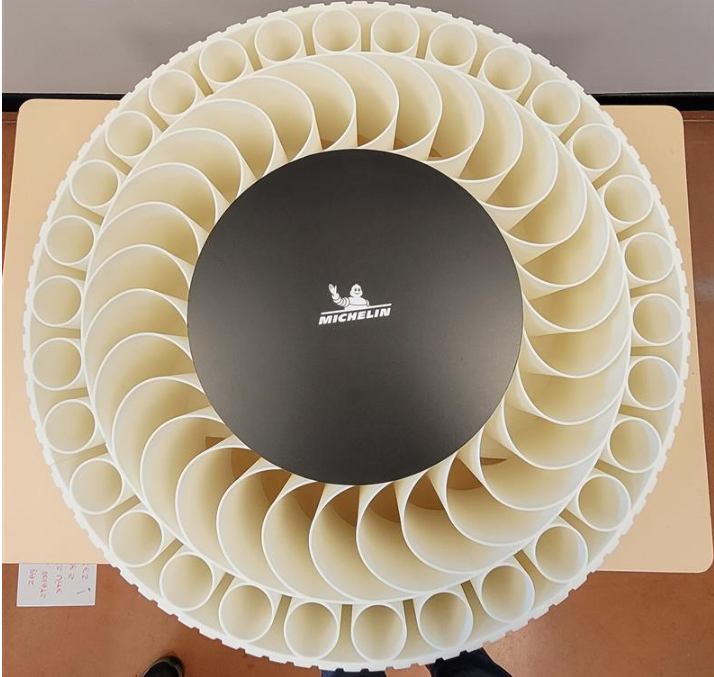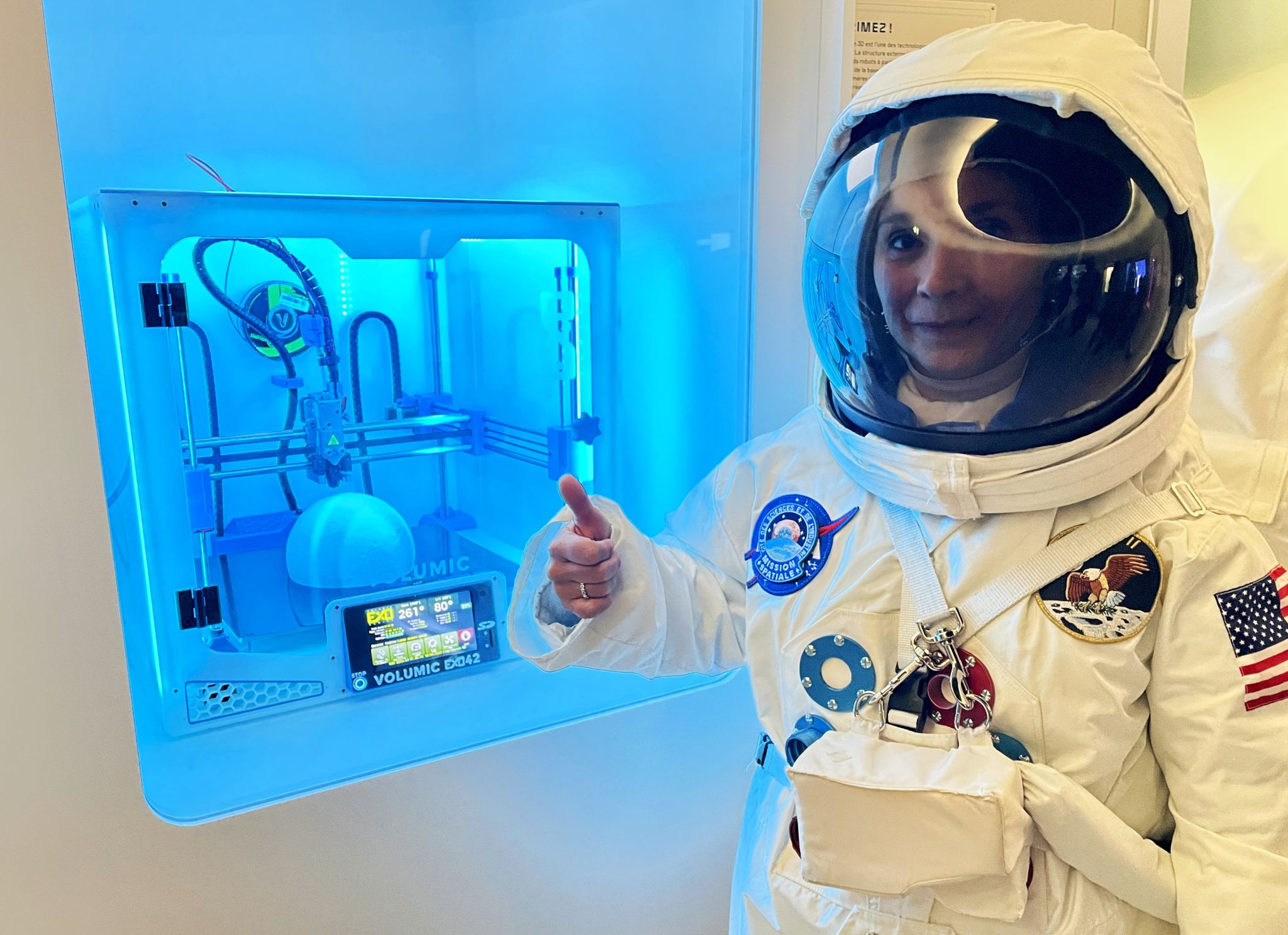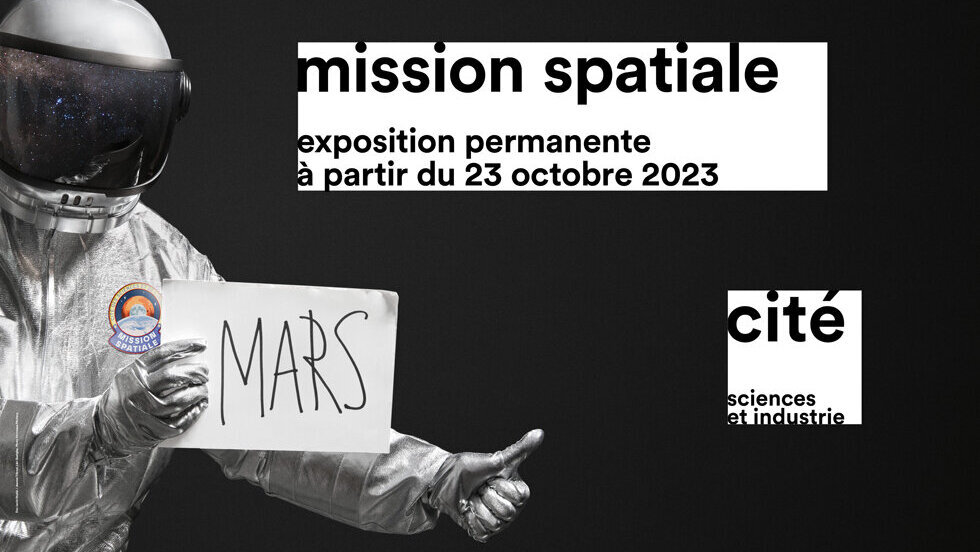Innovation meets tradition as Michelin (ENXTPA: ML) exhibits its latest lunar wheel at the Cité des Sciences et de l’Industrie museum in Paris, setting a new standard in tire technology. A name synonymous with tire innovation, Michelin has once again broken barriers with its latest creation: a wheel designed specifically for lunar rovers. It is exhibited at the newly opened Space Mission, a permanent exhibition dedicated to space exploration. This prototype shares the spotlight with a replica of NASA’s Orion spacecraft and another of the I-HAB, the European habitat module of the Lunar Gateway station. The exhibition also features numerous technological advances in space exploration. Visitors can also find other 3D printed objects and even a specialized 3D printer from Volumic3D, aimed to make future astronauts more autonomous in their interstellar journeys.
Michelin’s Director of Research and Development, Eric-Philippe Vinesse, said the latest Michelin wheel is a “huge leap in tire technology.” Engineers designed the lunar device to withstand the Moon’s harsh conditions. From surviving temperatures ranging from above 100°C (212°F) to below -240°C (-400°F) and resisting harmful solar and galactic radiation, to ensuring durability on soft and aggressive terrains, Michelin’s tire checks all the boxes. To assess its strength against moon-like conditions, researchers tested the wheel in France’s Volcan de Lemptégy. This location is known for its geological similarities to lunar terrain. However, it does not replicate the Moon’s reduced gravity, lack of atmosphere, or extreme temperature variations.

Photo of Michelin’s wheel at the Space Mission exhibit in Paris. Image courtesy of François Boismenu via LinkedIn.
Moon-ready wheel
With a backdrop of these technological demands, Michelin has once again demonstrated its commitment to pushing boundaries. In 2022, Michelin unveiled the first prototype of this lunar wheel. This 3D printed model, grounded in biomimetics, boasted an airless structure designed to maintain the efficiency and longevity of rovers in the challenging environment of the lunar south pole. Then, the company’s ongoing efforts to develop a lunar-suitable wheel reached a significant milestone. As part of a collaboration with Northrop Grumman and AVL, the company revealed a Tweel tire hybrid at the CES event in Las Vegas. This team is preparing to equip a Lunar Terrain Vehicle (LTV) that competes for a NASA lunar mission contract, projected to kick off by 2028.

Michelin’s original 2022 3D printed prototype of the lunar-ready wheel we see in 2023’s museum exhibit in Paris. Image courtesy of Michelin.
With this recent unveiling in Paris, Michelin further cements its dedication to advancing tire technology for extraterrestrial terrains. The company’s collaboration with Northrop Grumman and AVL directly responds to the call of NASA’s Artemis program. Aimed at ensuring humans return to the Moon and establish a sustainable presence, the program presents unique challenges, especially in mobility. Drawing from its rich legacy of creating airless tires and state-of-the-art materials, Michelin continues to innovate its lunar wheel to eventually help astronauts travel the Moon’s terrains.
The latest lunar wheel proof of concept is no ordinary tire. It’s an evolution of the award-winning Michelin Tweel assembly, which was showcased at CES. This structure retains the wheel’s flexibility, ensuring it consistently maintains contact with the lunar surface, making it drastically more efficient. In direct comparisons, it offers an impressive 3.3 times improvement over wheels used in the historic Apollo Lunar Rover missions. As the clock ticks toward the Artemis program’s deadlines, Michelin is streamlining its product.
Driving on the Moon
Coinciding with Michelin’s lunar wheel debut, the European Space Agency (ESA) introduced new moon road construction techniques. According to the space agency, scientists have developed methods to melt simulated lunar dust into a solid surface, potentially providing the perfect terrain for Michelin’s lunar wheel. An ESA project reported in Nature Scientific Reports tested the creation of roadworthy surfaces by melting simulated moondust with a powerful laser.
“Where we’re going, we DO need roads! To keep abrasive, sticky lunar dust at bay on the Moon, astronauts will need paved roads and landing pads. But how can we build roads on the Moon? Scientists on Earth have been experimenting with simulated lunar dust, and they have found a way of melting it into a glassy solid surface,” explains Tomassi. Proceeding through trial and error, researchers devised a strategy using a 4.5 cm diameter laser beam to produce triangular, hollow-centred geometric shapes approximately 20 cm across on-site. These could be interlocked to create solid surfaces across large areas of lunar soil, which could serve as roads or landing pads.
Space-tech marvels
Michelin’s 6,000-strong R&D team exemplifies its commitment and has allowed the company to envision a future where mobility solutions extend beyond Earth. Since 2017, Michelin has showcased its vision of a biosourced, connected, and renewable tread through 3D printing. This concept influences some of the brand’s most innovative projects, like the lunar flexible airless tire they are showcasing today at the Paris space expo. One of the defining moments for the brand was unveiling its VISION concept. This was a groundbreaking representation of the future of tires up to 2050. A combination of both wheel and airless tire, VISION is biosourced, connected, and boasts a renewable tread (much like the latest lunar wheel). One of its standout features is the ability to recharge the tread using 3D printing.
Capitalizing on this technology, the tread can be customized on-the-fly to cater to individual needs, enhancing comfort, safety, and sustainability. Whether adapting tires for seasonal conditions or optimizing rubber compound use, 3D printing makes these adjustments swift and efficient. Michelin stands as a pioneer in metal additive manufacturing, applying this expertise in designing tire mold components. The company is pushing the boundaries even further with its strides in rubber 3D printing. All these innovations culminate in their current project, the lunar flexible airless tire.
Legacy and innovation
At the Cité des Sciences et de l’Industrie museum in Parc de la Villette, Michelin’s lunar wheel is a testament to innovation. However, it is also joined by other 3D printed space advances. For example, French 3D printer manufacturer Volumic3D announced its participation in this space-centric exhibition. On display is its educational version of the large format FDM 3D printer model EXO 42, modified with a “space” variant. This specialized machine equips future astronauts with an unprecedented level of autonomy in space exploration.

Volumic3D’s EXO 42 3D printer model at the Space Mission expo in Paris. Image courtesy of Volumic3D.
Visitors can see other 3D printed curiosities, like the models of future gateways and various lunar habitats. One of the most notable exhibits on site is the Lunar Lantern sustainable outpost from SEArch+. ICON commissioned this design for Project Olympus as part of NASA’s Moon-to-Mars Planetary Autonomous Construction Technologies (MMPACT) program. The Lunar Lantern celebrates its double-protective outer shield structure. This design prioritizes the safety and security of its inhabitants during humankind’s extended missions on the lunar surface. SEArch+, ICON engineers, and NASA collaborated on this design. They plan to 3D print the Lunar Lantern directly on the Moon using regolith.
After nearly two years of joint efforts, the exhibit paints a vivid picture of the future. It showcases how 3D printing paves the way for innovative solutions in space conquest. From the tires that will carry crews from one 3D printed outpost to another to the printers meant for daily use, these propositions highlight the evolving landscape of space exploration.
Subscribe to Our Email Newsletter
Stay up-to-date on all the latest news from the 3D printing industry and receive information and offers from third party vendors.
Print Services
Upload your 3D Models and get them printed quickly and efficiently.
You May Also Like
The Dental Additive Manufacturing Market Could Nearly Double by 2033, According to AM Research
According to an AM Research report from 2024, the medical device industry, specifically in dentistry, prosthetics, and audiology, is expected to see significant growth as these segments continue to benefit from...
Heating Up: 3D Systems’ Scott Green Discusses 3D Printing’s Potential in the Data Center Industry
The relentless rise of NVIDIA, the steadily increasing pledges of major private and public investments in national infrastructure projects around the world, and the general cultural obsession with AI have...
AM Research Webinar Explores Continuum’s Sustainable Metal Additive Manufacturing Powders
Metal additive manufacturing (AM) powder supplier Continuum Powders is working to develop solutions that empower industries to reduce waste and optimize their resources. An independent life cycle assessment (LCA) of...
3D Printed Footwear Startup Koobz Lands $7.2M in Seed Round
California-based Koobz is focused on reshoring the U.S. footwear supply chain with advanced manufacturing processes, including 3D printing. The startup just announced that it has added $6 million to its...


































